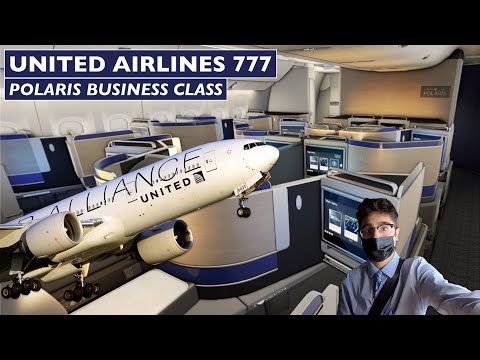United 777-200ER POLARIS BUSINESS CLASS: Full Flight Review!

My inbound flight had arrived just a few minutes earlier into Terminal 3 Concourse G. My next flight would be departing from Terminal 1 Concourse B. The nice thing about Chicago O’Hare is that Terminals 1, 2, and 3 are all connected by walkways so you can walk amongst the terminals without any issue. It took me no less than five minutes to
walk from Terminal 3 to Terminal 1 and relive some old childhood memories along the way. O’Hare is bustling with passengers today and quite honestly I was overwhelmed (in a good way) by just how many people were flying. As travel demand continues to surge, United recently announced they would be hiring hundreds more pilots next month, a sign of things slowly returning to normal. Today we’re onboard the 8:50am flight 2465 to Denver, departing out of gate B16.
B16 is located at the north end of Concourse B and along with B17, it’s one of only two widebody gates at this concourse. These two gates are regularly used by United, All Nippon Airways, and Lufthansa. In my opinion, B16 is the better gate because it has more seats available and you also get a nice view of the aircraft. United only had one lounge open in Concourse B, that being the one in the southern part of the terminal. The one by my gate in the north end was unfortunately closed but either way I didn’t have enough time to make a visit. Business class passengers are assigned to Group 1 for boarding, but in reality they can board whenever they’d like. United has adjusted their boarding process
such that they board the plane from back to front and they deplane from front to back. These are trends many airlines have adopted lately to limit close contact among passengers. United’s internationally-configured 777-200ER features just 276 seats, 50 of them being in Polaris Business Class. The seats are laid out in a spacious 1-2-1 configuration and each seat has direct aisle access. The 50 business class seats are distributed across two parts, with rows 1-8
taking up the front section and the remaining rows 9, 10, 11, 12, and 15 being allocated to a smaller, more private section. Odd-numbered “A” and “L” seats are positioned closer to the window, whereas the even-numbered “A” and “L” seats are angled away from the window. So if you’re traveling solo, be sure to select one of the odd-numbered “A” or “L” seats for maximum privacy. We’ll tour the rest of the aircraft once airborne, but until then I’ll get settled into my seat for today’s two-hour journey to Colorado, 9A.
One thing I noticed about the traytable is that there’s a built-in device holder, so basically you could place your mobile device here and watch your own shows but why would you wanna do that when you’re facing this the whole flight. WiFi is available however internet access requires you to pay a fee. Aside from that the UnitedWiFi website has roughly the same content as the inflight entertainment system.
But you know what’s not absolutely amazing? The fact that over 80% of my viewers aren’t even subscribed to the channel! If you’re new to my channel, I’d like to extend you a very warm welcome. If you like videos related to all things aviation, then please consider subscribing to the channel and enabling your post notifications so you don’t miss out on some of YouTube’s greatest aviation content. Seat 9A is located right behind one of the business class lavatories. The lavatory was clean and well-stocked with amenities like extra sanitizing wipes, hand cream, and face mist.
Taking a little walkthrough of the 777, we can see that nearly all of the 276 total seats on this aircraft are filled. Economy class features 156 seats and is laid out in a 3-4-3 configuration with each seat having inflight entertainment screens, power outlets, and 31 inches of legroom. Economy Plus features just 46 seats but is very similar, the only difference being it offers three extra inches of legroom. United’s Premium Plus cabin (also known as Premium Economy)
features 24 seats in a 2-4-2 configuration, with each seat having 38 inches of legroom. Finally there’s Polaris Business Class, which as mentioned earlier, has 50 seats in a 1-2-1 configuration with each seat providing a whopping 78 inches of legroom. The flight isn’t long enough to make good use of the inflight entertainment, but I went ahead and tried out the headphones United offers. The headphones seem to be made of some cheap plastic but nevertheless have relatively decent sound quality. Then again, I’m not too knowledgeable on business class headphones.
Unfortunately, as I was recording my concluding thoughts on the flight, one of the flight attendants (whom I had never seen before until now) came by and told me filming wasn’t allowed. So therefore, I’ll have to do a voiceover to give you all my concluding thoughts on the flight. United’s Polaris Business Class is an excellent product and I would love to someday get the full experience on a longer flight. The seat was excellent and the amenities it offers will without a doubt keep you set for a long-haul flight. The service was of course limited but I did appreciate the small breakfast. The crew did a great job enforcing safety guidelines and I was pleasantly surprised to see hand sanitizing stations set up throughout the aircraft. Unfortunately the
one area where I was slightly disappointed was the cleanliness. Parts of my seat were noticeably dity and even when I looked behind the seat, I could tell the cleaning crews missed out on some areas. But overall I really enjoyed this flight and it’s a shame that it had to come to an end this quickly. Throughout the flight, our routing was relatively simple,
we basically just flew in a straight line for two hours. Similarly, our approach into Denver was very straightforward as well. We would continue flying perpendicular to the airport before finally making one big 90 degree turn and coming straight in to land on RWY 16L. Welcome to Denver, it felt great to be back in the Mile High City after over six years. Before I go, let's briefly talk about how much I paid for this flight and how I managed to fly one of these internationally-configured planes on a domestic flight.
As far as price goes, I paid just $172 for this one-way ticket in business class and I’m glad I booked it when I did as just a few days later, the price jumped up to nearly $400. So how exactly did I end up on this aircraft? Because normally, the aircraft I flew would not operate a domestic route like this. Well, United has 19 777-200 non-ER’s that were mainly used for domestic flights like this, including those to Hawaii. These 777’s along with 33 777-200ER’s were powered by Pratt & Whitney engines and are all currently grounded due to recent issues involving that engine type. The aircraft I flew on is one of 22 777-200ER’s that United inherited from Continental Airlines in 2010 as a result of the merger. These 777’s
were never grounded because of the fact that they use General Electric GE90 engines and not Pratt & Whitneys. So until the other 777’s return to service, United will continue operating these GE90-powered aircraft on select domestic flights, including those to Hawaii. Thank you so much for joining me on this epic flight. Stay tuned for the next few videos which will include a look at Denver Airport’s new Concourse B expansion and my next flight from Denver to Atlanta on Delta’s 767-400.
If you enjoyed this video please leave a like to show your support and a comment on how I can improve. Thanks again for watching and I’ll see you in the next one.
2021-04-13 20:29


